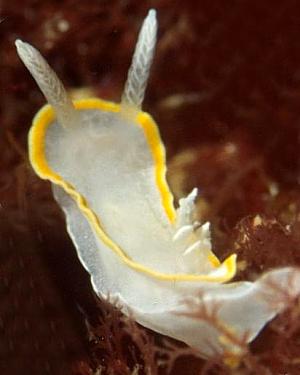
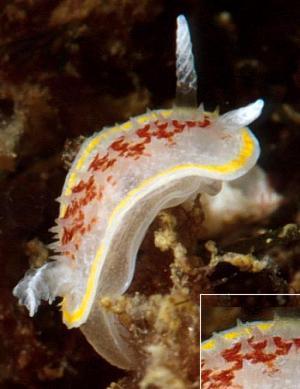
Diaphorodoris luteocincta
(M. Sars, 1870)
Order: NUDIBRANCHIA
Suborder: DORIDINA
Superfamily: ANADORIDOIDEA
Family: Onchidorididae
DISTRIBUTION
Common in the western Mediterranean but known from as far north as Norway
PHOTO
Baie de Peyrefitte (Mediterranean French/Spanish frontier).
UPPER PHOTO: Diaphorodoris luteocincta 'var alba (Portmann & Sandmeier, 1960)' 6m depth, size 12 mm.
LOWER PHOTO: Diaphorodoris luteocincta 'var reticulata (Portmann & Sandmeier 1960)' 3m depth, size 5 mm.
PHOTOS: Patrick Heurtaux.
White with a submarginal bright yellow border and prominent pointed papillae on mantle. There can be blotches of red, or a red reticulate pattern in the centre of the mantle. It grows to about 11mm long. Portmann & Sandmeier, (1960) proposed that the two colour forms illustrated here should be considered distinct and proposed the 'variety' names Diaphorodoris luteocincta var alba and Diaphorodoris luteocincta var reticulata but these names have not been accepted by most workers who consider the colour variation found in the 'species' is a continuum. However see Bernard Picton's message below where he strongly argues that there are two distinct species.
Reported by Thompson & Brown (1984) to feed on the ectoproct bryozoans Smittina reticulata, Cellepora pumicosa and species of Crisia.
Reference:
• Thompson, T.E. & Brown, G.H. (1984) Biology of Opisthobranch Molluscs, Vol 2. Ray Society: London.
Rudman, W.B., 2001 (March 2) Diaphorodoris luteocincta (M. Sars, 1870). [In] Sea Slug Forum. Australian Museum, Sydney. Available from http://www.seaslugforum.net/find/diaplute
Related messages
Diaphorodoris luteocincta from Portugal
April 23, 2008
From: Joao Pedro Silva
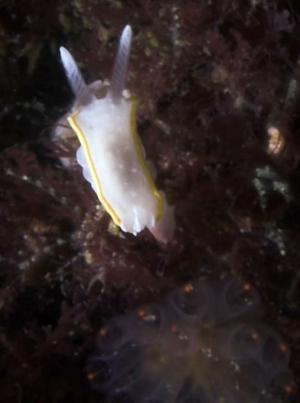
Dear Bill,
When I first saw this I thought it was a small Chromodoris purpurea. Only when I looked at the photos on the computer screen I noticed one major flaw on the ID: the rhinophores and branchia were white. It looks like the "alba" variant of Diaphorodoris luteocincta but as it's a first for me I'd like a confirmation on the ID.
Locality: Sesimbra, 10 m, Portugal, North Atlantic, 20 September 2007, Rocky bottom. Length: aprox. 1 cm. Photographer: Joao Pedro Silva.
Cheers,
Joao Pedro
jpsilva@uwphotographer.net
Silva, J. P., 2008 (Apr 23) Diaphorodoris luteocincta from Portugal. [Message in] Sea Slug Forum. Australian Museum, Sydney. Available from http://www.seaslugforum.net/find/20797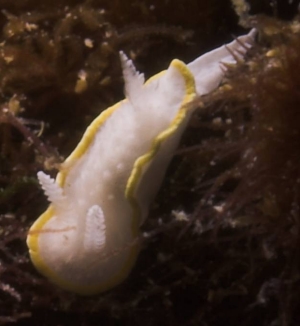
Dear Joao Pedro,
Yes this is Diaphorodoris luteocincta.
Best wishes,
Bill Rudman
Diaphorodoris luteocincta with a strange spot
April 23, 2008
From: Dominique Horst
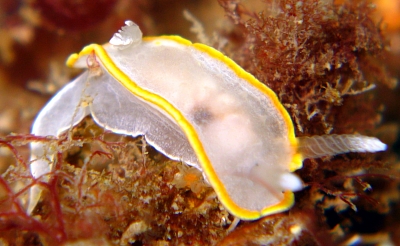
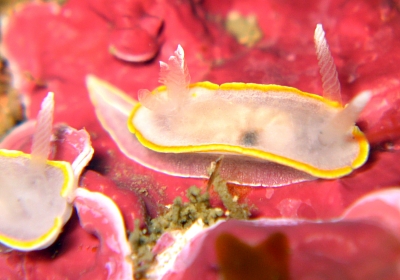
Concerning message #21506:
Hi Bill,
This Diaphorodoris luteocincta has a strange dark red spot inside.
Could this be food or some damage, or something else...?
Locality: Antibes Cape, 12 m, France, Mediterranean sea, 19 April 2008. Length: 7 mm. Photographer: Dominique Horst.
Best regards,
Dominique
dominique.horst@wanadoo.fr
Horst, D., 2008 (Apr 23) Diaphorodoris luteocincta with a strange spot. [Message in] Sea Slug Forum. Australian Museum, Sydney. Available from http://www.seaslugforum.net/find/21537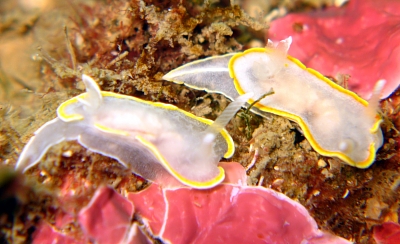
Dear Dom,
It's a bit difficult to be sure, but there seems to be a similar spot in both animals so it's probably an anatomical feature. One possibility is that it is a spherical sac in the reproductive system called the bursa copulatrix which stores sperm and seminal fluid immediately after copulation. In many animals it has a dark brown wall rather than the usual translucent whitish colour. I am not sure if it is dark brown in D. luteocincta, but that would be my guess.
Concerning damage. I am surprised that both animals have quite a bit of damage to the mantle edge.
Best wishes,
Bill Rudman
Re: Diaphorodoris luteocincta from France
April 17, 2008
From: Dominique Horst
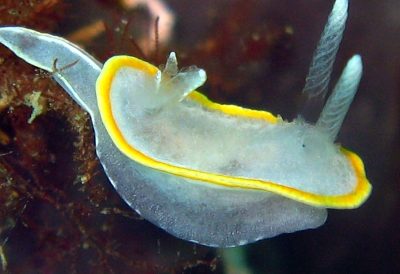
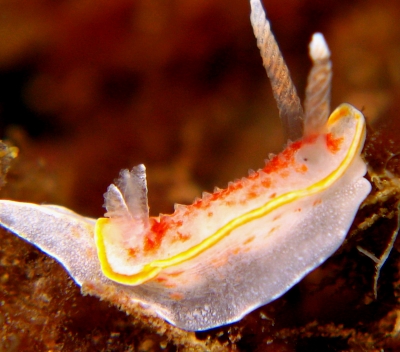
Concerning message #20029:
Hello Bill,
This is the first time I have seen Diaphorodoris luteocincta with the red back, [var reticulata?]
Not sure on these pictures if the shape is very different between the two.
All these pictures were taken exactly at the same place separated by 3 weeks. The obvious difference is the red colour on the back, and also spots on the side and red spread on the rhinophores.
Locality: Antibes, 12m, France, Mediterranean sea, 7 April 2008. Length: 12mm. Photographer: Dominique Horst.
If I understand, the discussion is still open about variety or species?
Kind regards,
Dom.
dominique.horst@wanadoo.fr
Horst, D., 2008 (Apr 17) Re: Diaphorodoris luteocincta from France. [Message in] Sea Slug Forum. Australian Museum, Sydney. Available from http://www.seaslugforum.net/find/21506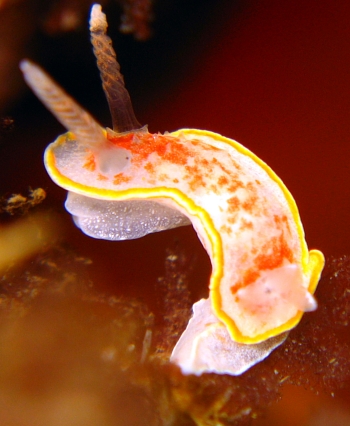
Dear Dom,
Thanks for these photos. The red spots on the body and red on the rhinophores seem a bit unusual, but the general consensus is that we are dealing with a single species. However Bernard Picton argues quite strongly for two species. In taxonomy the debate is never finished, it may go quiet for a while, but then someone will find a difference or biological observation which starts it all up again. In this case the important thing is to keep a small doubt in the back of your mind about Diaphorodoris luteocincta. Then if sometime in the future you come across a small anomaly - perhaps you will find them laying different sized eggs, or you see oneof each colour form mating together - you will realise you have seen something interesting and take a photo.
Best wishes,
Bill Rudman
Re: Diaphorodoris luteocincta from France
June 25, 2007
From: Dominique Horst
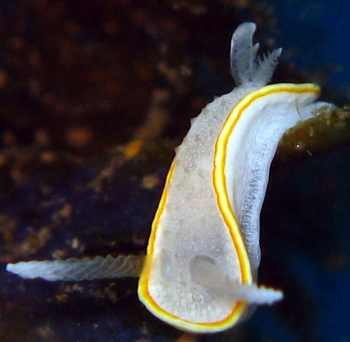
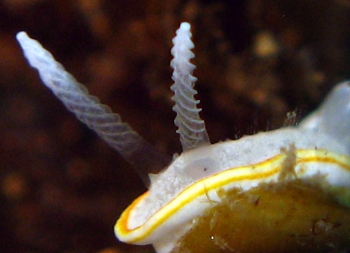
Concerning message #7576:
Hello Bill,
I suppose this is Diaphorodoris luteocincta var alba?. Any news about the distinction on varieties or different species ? Anyway, this another very nice slug and I'm happy to share these pictures on the forum.
Locality: Cannes, 20m, France, Mediterranean sea, 13/05/2007. Length: 5-6 mm. Photographer: Dominique HORST.
As in my previous message about D. papillata, [#20020 ] the same eyes can be observed at the transparent base of the rhinophores.
Kind regards,
Dominique
dominique.horst@wanadoo.fr
Horst, D., 2007 (Jun 25) Re: Diaphorodoris luteocincta from France. [Message in] Sea Slug Forum. Australian Museum, Sydney. Available from http://www.seaslugforum.net/find/20029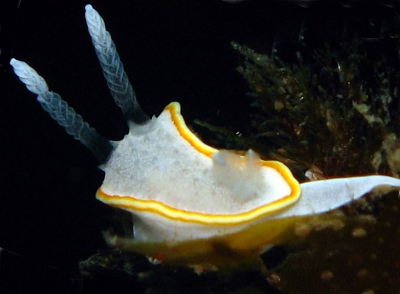
Dear Dom,
I am not sure if I expect any news soon on whether this is a variety or a separate species. I agree with Bernard Picton's feelings [message #4838] that there is probably more than one species, but I don't know of any one working on the problem.
Best wishes,
Bill Rudman
Diaphorodoris luteocincta from Croatia
June 10, 2006
From: Andrej Jaklin
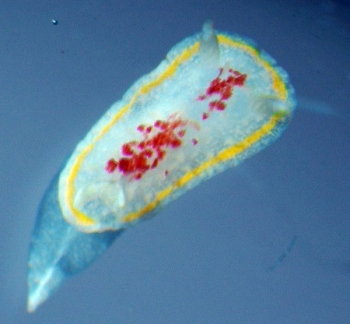
Dear Bill,
This Diaphorodoris luteocincta should be a new one for the Adriatic nudibranch fauna.
Unfortunately I can't give you any details as I found it on the front aquarium glass at the entrance to the Institute. Only I know is it was hidden somewhere with the material collected around Rovinj.
Locality: Rovinj, Croatia, Northern Adriatic, 13 May 2006. Length: 9 mm. Photographer: Andrej Jaklin.
The attached picture is of very poor quality but I hope it can be taken as proof that the species was really found.
Best regards,
aj
jaklin@cim.irb.hr
Jaklin, A., 2006 (Jun 10) Diaphorodoris luteocincta from Croatia. [Message in] Sea Slug Forum. Australian Museum, Sydney. Available from http://www.seaslugforum.net/find/16822Dear Andrej,
It certainly looks real to me. It's good we have so many pairs of eyes out looking. I guess since we have records on the Forum from Turkey, we could predict it would be found in the Adriatic, but it is nice to actually make the prediction come true.
Best wishes,
Bill Rudman
Diaphorodoris luteocincta spawn?
April 14, 2006
From: Jim Anderson
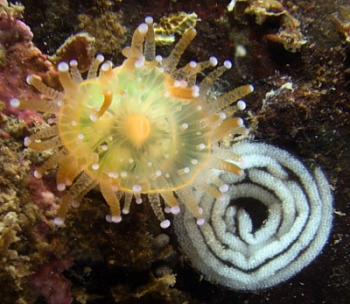
Dear Bill,
This spawn spiral was taken on a reef wall covered with Corynactis viridis anemone and several Diaphorodoris luteocincta. Bernard Picton has said it might be their spawn and I wondered if anyone out there could confirm.
Locality: Sgeir Mhor, Isle of Skye, 18 m, Scotland, Atlantic Ocean, 8 April 2006, vertical rocky reef. Length: 10 mm dia. Photographer: Jim Anderson
Kind regards,
Jim A
jander4454@gmail.com
Anderson, J., 2006 (Apr 14) Diaphorodoris luteocincta spawn?. [Message in] Sea Slug Forum. Australian Museum, Sydney. Available from http://www.seaslugforum.net/find/16320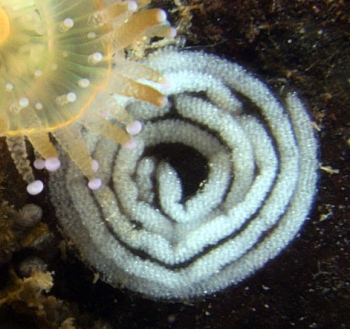
Dear Jim,
Hopefully someone has seen or photographed the egg ribbon of this species.
Best wishes,
Bill Rudman
Diaphorodoris luteocincta from Turkey
August 25, 2003
From: Ferda Buyukbaykal
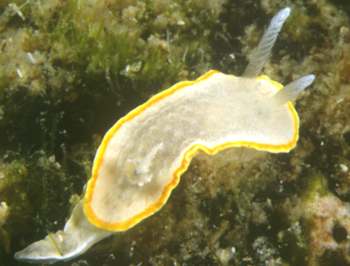
Dear Bill,
Is this Diaphorodoris luteocincta?.
Date: June 13 , 2003
Location: Antalya, Tekirova
Site: Uc adalar
Depth: 10-12 mt
Size: 25-30 mm
Photos: Ferda Buyukbaykal
Best regards
Ferda
ferdabbaykal@isnet.net.tr
Buyukbaykal, F., 2003 (Aug 25) Diaphorodoris luteocincta from Turkey. [Message in] Sea Slug Forum. Australian Museum, Sydney. Available from http://www.seaslugforum.net/find/10816Dear Ferda,
Yes this is Diaphorodoris luteocincta.
Best wishes,
Bill Rudman
Onchidoris luteocincta breeding habits
March 18, 2003
From: R.J. Wright
Please could you help me understand the breeding habits of Onchidoris luteocincta. It states that it is hermaphroditic but what does that really mean. Has it still got to find a mate on a breeding cycle every year etc or can it breed asexually without ever meeting another slug, ie cloning. If so what happens to the gene pool; or can it have one encounter with another slug and store the sperm/eggs for the rest of its life cycle like Bees.
Thanks,
RJW
royjames@wright07.freeserve.co.uk
Dear Roy,
When you ask about Onchidoris luteocincta I guess you mean Diaphorodoris luteocincta. Species of Onchidoris and Diaphorodoris are both in the family Onchidorididae but are considered to be sufficiently different to be in separate genera. However the identity of the slug your interested in isn't that important because your question applies to all opisthobranchs.
Basically all sea slugs are hermaphrodites which means they have a fully functional set of both male and female reproductive organs. When they reach maturity, which can take a few days to a few months in different species, they find a partner and mate. They lay their eggs in an elaborate egg ribbon and then the eggs develop either directly into a small crawling slugs or indirectly into a swimming veliger larvae. They definitely need to find a mate for breeding and when they do so mating is often reciprocal - which means they both act as male and female simultaneously. In some species the male system develops before the female system. In those cases it seems the animal can act as just a male during mating. I don't know if there has been any research to show that sperm can be stored for long periods of time.
If you have a look at the pages on Life Span, Reproductive System and Larvae you will find information and links to other pages which will give you more background information. Be sure to check out the messages and discussions that are found at the botton of each page as that is where you will find much of the information on the Forum. Also go to the General Topics Page and look through the Index.
Best wishes,
Bill Rudman.
Diaphorodoris luteocincta from France
July 30, 2002
From: Marina Poddubetskaia

Dear Bill,
Here is a photo of the 'var alba' form of Diaphorodoris luteocincta.
Date: June 30, 2002
Location: Cerbere, France [Mediterranean coast]
Site: Canadells
Depth: 11m
Size: about 2cm
Photos: Marina Poddubetskaia - Nembro website
Best wishes,
Marina.
nembro@nembro.info
Poddubetskaia, M., 2002 (Jul 30) Diaphorodoris luteocincta from France. [Message in] Sea Slug Forum. Australian Museum, Sydney. Available from http://www.seaslugforum.net/find/7576Thanks Marina,
Bill Rudman
Re: Diaphorodoris luteocincta from Turkey
June 14, 2002
From: Juan Lucas Cervera
Hi Bill,
The identification is correct.
Lucas.
lucas.cervera@uca.es
Cervera, J.L., 2002 (Jun 14) Re: Diaphorodoris luteocincta from Turkey. [Message in] Sea Slug Forum. Australian Museum, Sydney. Available from http://www.seaslugforum.net/find/7249Thanks Lucas,
Bill Rudman
Diaphorodoris luteocincta from Turkey
June 8, 2002
From: Baki Yokes
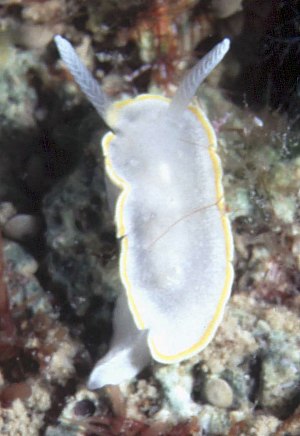
Hi,
Here is a Diaphorodoris luteocincta 'var' alba from Turkey. I think this photo extends the distribution of this species to Eastern Mediterranean.
photo: Baki Yokes
Date: 3 May 2002
Place: Antalya, Tukey
Dive site: Uc Adalar
Depth: 15m
Size: 2cm
Best wishes
Baki
bakiyokes@turk.net
Yokes, B., 2002 (Jun 8) Diaphorodoris luteocincta from Turkey. [Message in] Sea Slug Forum. Australian Museum, Sydney. Available from http://www.seaslugforum.net/find/7167Thanks Baki,
Yes I think you are correct with this being the first record from the eastern Mediterranean, but perhaps someone can confirm that for us.
Best wishes,
Bill Rudman
Diaphorodoris luteocincta and var. alba
July 19, 2001
From: Bernard Picton
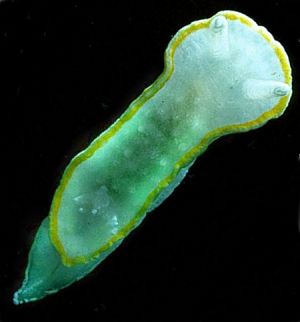
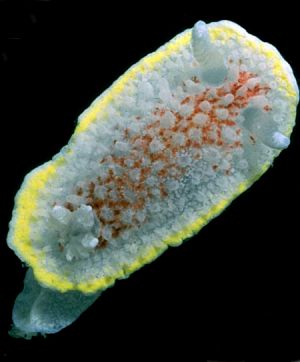
Hi Bill,
I just had another look at your page on this species and I want to disagree over the status of these two 'varieties'. I think they are distinct species. I've seen large numbers of var. reticulata but only a few var. alba over the years I've been collecting. Var. reticulata is common throughout the British Isles and extends north to Norway whilst var. alba only occurs as far north as the SW of England and South Wales. In the Mediterranean the reverse is true with alba being the common form and reticulata being scarce. As Patrick's excellent photographs show there are several colour and structural differences between the two. Apart from the obvious red in the middle of the back var. reticulata has a submarginal yellow band which is often slightly broken, whilst var. alba has a continuous band of orange-yellow which extends right to the margin. Var. reticulata has more papillae on its (wider) back which are much taller than those in var. alba. The body shape is different with var. alba much narrower and taller like a typical Hypselodoris and var. reticulata much flatter like a typical Chromodoris.
Tom Thompson claimed to have seen gradation between these forms, but I must disagree with him, they have always been very distinct when I've seen them and some divers have sent me var. alba pictures in the last few years saying that they find them distinctively different to the more familiar var. reticulata.
I've recently collected the two forms at the same dive site in the Scilly Islands and been able to compare them alive. I've also looked at the radulae but there is no difference there. I've attached photos of the animals from the Scilly Isles, Cornwall (Trinity Rock - April 2001)
UPPER: var. alba 8mm
LOWER: var. reticulata 10mm.
The only question in my mind is should we call the white form (alba) Diaphorodoris alba or should it get a new name altogether? I see that the rules of nomenclature say a variety name given before 1961 can be treated as subspecific and therefore be available unless the author categorically says that infrasubspecific rank is meant, in which case it may still be used if the name has been treated as available or used for a species or subspecies before 1985! (1985 code, article 45g).
Bernard
bernard.picton.um@nics.gov.uk
Picton, B., 2001 (Jul 19) Diaphorodoris luteocincta and var. alba. [Message in] Sea Slug Forum. Australian Museum, Sydney. Available from http://www.seaslugforum.net/find/4838Dear Bernard,
It's a pity you couldn't find some nice morphological difference in the radula. Are they both found together on the same bryozoans? I see Thompson & Brown report a flattened egg ribbon. It would be nice to know if both 'varieties' had the same shaped egg ribbon.
I agree that the external differences certainly look real but it would be useful to have some correlating evidence - either biological or anatomical.
I also agree that the nomenclatural problem needs sorting out. Firstly I guess you have to resolve whether Portmann & Sandmeier used 'variety' as an infrasubspecific term or as a category equivalent to subspecies. If the latter, then Thompson & Brown (1984) cite the names as Diaphorodoris luteocincta alba and Diaphorodoris luteocincta reticulata in a form suggesting they consider the names to have have subspecific equivalence, which would suggest 'alba' is available. But you would need to check this out.
In the meantime I will sit on the fence and keep both 'forms' together - but I note your views at the top of the page. And of course if anyone has views, photos, evidence about this, it would be very welcome.
Cheers,
Bill Rudman
Re: Photos of Diaphorodoris luteocincta
March 6, 2001
From: Juan Lucas Cervera
Dear Bill,
I agree with your views on Diaphorodoris luteocincta.
Lucas.
lucas.cervera@uca.es
Cervera, J.L., 2001 (Mar 6) Re: Photos of Diaphorodoris luteocincta. [Message in] Sea Slug Forum. Australian Museum, Sydney. Available from http://www.seaslugforum.net/find/3911Photos of Diaphorodoris luteocincta
March 4, 2001
From: Patrick Hertaux


Dear Dr Rudman
For your Forum, I send you 2 photos of Diaphorodoris luteocincta (Sars M 1870), which I took at the Baie de Peyrefitte (Mediterranean French/Spanish frontier)
UPPER PHOTO: Diaphorodoris luteocincta var alba (Portmann & Sandmeier 1960) was found at 6m depth, size 12 mm
LOWER PHOTO: Diaphorodoris luteocincta var reticulata (Portmann & Sandmeier 1960) was at 3m depth, size 5 mm.
Best wishes
Patrick Heurtaux
pheurtau@club-internet.fr
Heurtaux, P., 2001 (Mar 4) Photos of Diaphorodoris luteocincta. [Message in] Sea Slug Forum. Australian Museum, Sydney. Available from http://www.seaslugforum.net/find/3876Thanks Patrick,
This species is quite variable in colour. Portmann & Sandmeier's variety names don't seem to have been accepted by subsequent workers. I see Schmekel & Portmann (1982) don't use them, and Thompson & Brown (1984) report finding a gradation from one 'variety' to the other in southern England.
Best wishes,
Bill Rudman.
